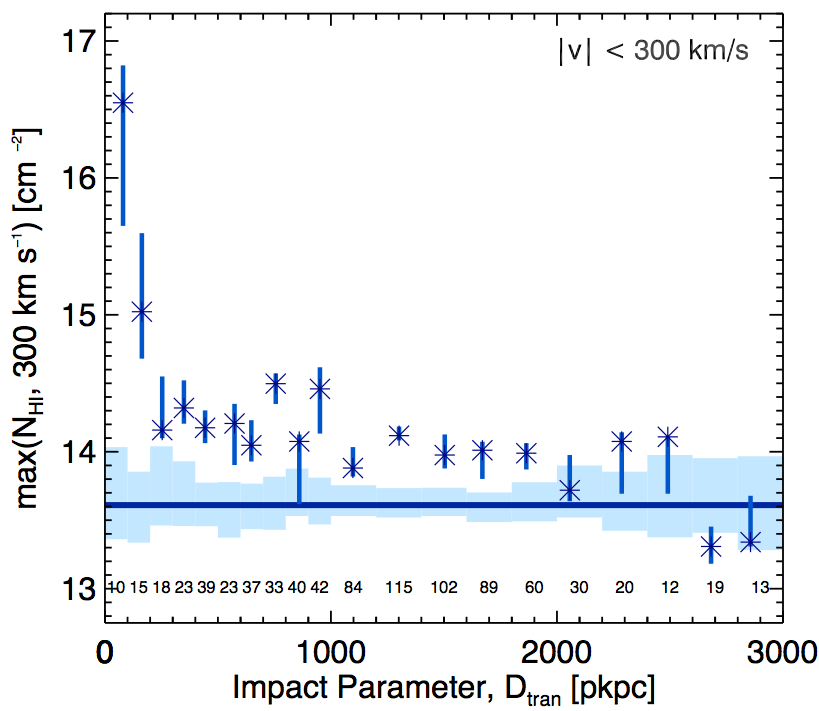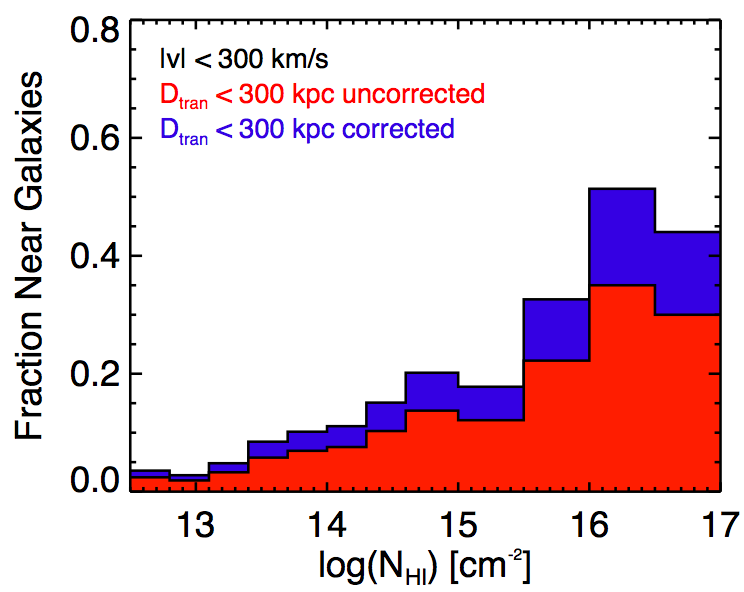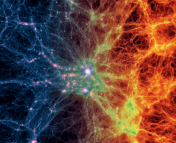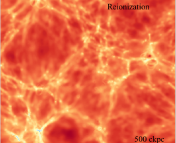Title: The Gaseous Environment of High-z Galaxies: Precision Measurements of Neutral Hydrogen in the Circumgalactic Medium of z ~ 2-3 Galaxies in the Keck Baryonic Structure Survey
Authors: Gwen C. Rudie et al.
First Author’s Institution: Caltech
Understanding how galaxies form depends critically on understanding the distribution of gas at high redshift. After all, you can’t make galaxies without stars, and you can’t make stars without gas! Even after galaxies form, there is a lot of evidence for continued interaction between galaxies and the intergalactic medium (IGM) via inflows and outflows, but these processes can be hard to model. In fact, numerical simulations are notorious for handling “feedback” processes poorly, making the results of simulations difficult to compare with actual observations. In cases like this, we would like to obtain high-precision measurements of the physical Universe, in order to constrain the next generation of models and hopefully develop a clearer idea of what is actually going on.

Figure 1: Log of the characteristic column density as a function of transverse distance. In this plot, the characteristic column density is taken to be the median column density of the strongest neutral hydrogen absorber within 300 km/s of a galaxy.
Of course, the trouble with mapping the location of gas in the Universe is that, for the most part, it’s only seen in absorption, and to make observations of absorbers, you need bright sources behind them to illuminate the “cosmic web”. If you’ve ever heard of quasar absorption line spectra, that is an important application of this principle and the one employed by many groups doing this kind of work. The Keck Baryonic Structure Survey (KBSS), for example, uses high-resolution spectra of quasars to make precision measurements of absorbers along the line-of-sight and tries to correlate them with galaxies in the surrounding field, whose redshifts are determined with low-resolution spectroscopy. The galaxies in the KBSS fields have z ~ 2-3, a redshift range that is particularly interesting because it corresponds to time in the history of the Universe when galaxies were most vigorously forming stars and quickly building up their mass.
In their paper, which appeared on astro-ph at the end of February, Rudie et al. report some results from the KBSS, specifically observations of the gas components at moderate distances from galaxies in the so-called circumgalactic medium (CGM). The CGM is similar to the more-familiar IGM in that it probes the regions between galaxies without stellar content, but is more strongly correlated with the positions of galaxies. One can imagine that this gas may have been influenced by galaxy evolution, and so understanding properties of the CGM could be important for understanding the baryonic processes that affect galaxy growth.
The analysis in the paper is very detailed, but the general idea is this:
1) High-resolution spectra for 15 extremely bright quasars in the KBSS fields are obtained using HIRES, and the absorption lines are simultaneously fit to find about 6000 individual neutral hydrogen (HI) absorbers. This sort of analysis is called Voigt-profile decomposition and relies, in part, on observing more than one line for a given species (Lyα, Lyβ, etc.) in order to identify a unique absorber. Because the sets of lines from different absorbers overlap and blend together, high-resolution and high signal-to-noise spectra are crucial for producing a robust fit.

Figure 2: Incidence maps for absorbers with respect to galaxy positions, with "incidence" simply meaning the number absorbers within a certain distance. On the left, the map shows the distribution of high column-density absorbers and the "finger of God" effect. On the right, the map shows low column-density absorbers. The compressed distribution in velocity space with respect to the transverse extent is evidence of infall on Mpc scales.
2) In the same fields, high-redshift star-forming galaxies are pre-selected based on their rest-UV colors (e.g., Lyman Break Galaxy analogs) and observed with LRIS to determine their actual redshifts. In total, 886 galaxies from the KBSS were included in the spectroscopic sample in the paper.
3) The two populations (absorbers and star-forming galaxies) are correlated with one another based on their 2D separation on the sky (also called the transverse distance) and their separation along the line-of-sight (in velocity space).
As expected from previous studies, absorbers (which can be thought of physically as dense regions of gas) were found to be clustered near galaxies in both transverse distance and velocity, but the authors found three distinct regions in the gas around galaxies (see Figures 1 and 2). In the region less than 300 kpc away from a galaxy, the total number and column density of absorbers is significantly higher than random locations in the IGM (up to 1000 times!). Farther away, between 300 kpc and 2 Mpc, the number column density plateaus and eventually drops off to a level consistent with the IGM at transverse distances greater than 2 Mpc. This is concrete evidence that high-column density gas around galaxies extends to much larger distances than previously thought, but it is important to note that the CGM of an individual galaxy is unlikely to reach these distances. Instead, because star-forming galaxies cluster at these redshifts, the elevated measurements between 300 kpc and 2 Mpc are likely probing the overlapping region of many galaxies’ CGM.

Figure 3: The fraction of absorbers contained in the CGM based on the spectroscopic sample of galaxies in the paper (red histogram) and the total photometric parent sample (blue histogram). At the highest column-densities, almost half of all absorbers are found to be closely correlated with the locations of galaxies.
Based on their results, the authors adopt an observationally-motivated definition of the CGM, which they take to be the region within 300 km/s in velocity and 300 kpc in transverse distance from a galaxy. At the redshift of these galaxies, the CGM of star-forming galaxies is only ~1.5% of the volume, but contains roughly 50% of all high column-density absorbers (Figure 3). This could have serious implications for studies of the IGM that rely on observations of NHI > 1014.5 cm-2 absorbers, which are shown to be associated with the CGM of galaxies and are not representative of the typical IGM.
In conclusion, although the idea of a circumgalactic medium is not new, this is the first attempt to say something quantitative about the full extent of the CGM around galaxies and provides an important measurement of the relevant scale for galaxy evolution at high-redshift. The analysis in this paper was restricted to studying the distribution of neutral hydrogen in the CGM, but future work will fold in metal-line absorption systems and, perhaps, galaxy properties in order to study the full effect the galaxies and the CGM have on one another.




